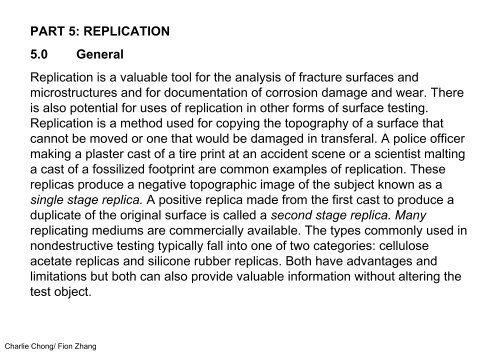ASNT Level III- Visual & Optical Testing
My Level III Self Study Notes Reading 4 Section 4B
My Level III Self Study Notes Reading 4 Section 4B
You also want an ePaper? Increase the reach of your titles
YUMPU automatically turns print PDFs into web optimized ePapers that Google loves.
PART 5: REPLICATION<br />
5.0 General<br />
Replication is a valuable tool for the analysis of fracture surfaces and<br />
microstructures and for documentation of corrosion damage and wear. There<br />
is also potential for uses of replication in other forms of surface testing.<br />
Replication is a method used for copying the topography of a surface that<br />
cannot be moved or one that would be damaged in transferal. A police officer<br />
making a plaster cast of a tire print at an accident scene or a scientist malting<br />
a cast of a fossilized footprint are common examples of replication. These<br />
replicas produce a negative topographic image of the subject known as a<br />
single stage replica. A positive replica made from the first cast to produce a<br />
duplicate of the original surface is called a second stage replica. Many<br />
replicating mediums are commercially available. The types commonly used in<br />
nondestructive testing typically fall into one of two categories: cellulose<br />
acetate replicas and silicone rubber replicas. Both have advantages and<br />
limitations but both can also provide valuable information without altering the<br />
test object.<br />
Charlie Chong/ Fion Zhang


















